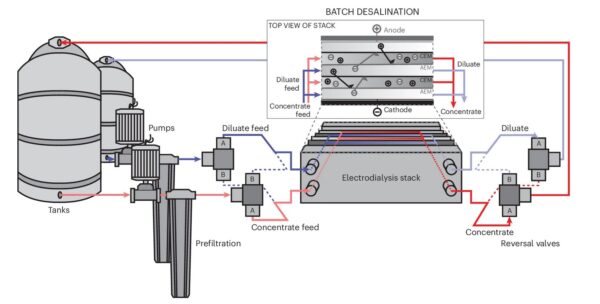Researchers at the Massachusetts Institute of Technology (MIT) have built a brackish groundwater desalination system that is powered exclusively by PV power and is purportedly able to promptly react to small changes in solar radiation to maximize solar energy generation.
“The solar-powered system removes salt from water at a pace that closely follows changes in solar energy,” the research team said in a statement. “As sunlight increases through the day, the system ramps up its desalting process and automatically adjusts to any sudden variation in sunlight, for example by dialing down in response to a passing cloud or revving up as the skies clear.”
The system is based on photovoltaic electrodialysis (PV-ED) technology enabling direct-drive desalination at high production rates and with no or little energy storage being required. PV-ED consists of a mass separation process that uses DC power to electrically charge membranes and an electrical potential difference, which are then used to separate ionic species from an aqueous solution.
This desalination technology is claimed to have higher water recovery rates, easier operation, longer membrane lifetime, and improved operation at high temperature compared to reverse osmosis (RO) techniques. A broad commercial adoption, however, has been prevented to date by limitations such as membrane fouling and permselectivity, which measure the ability of a membrane to discriminate between anions and cations.

The system consists of solar panels, maximum power point tracking (MPPT), batch tanks, parallel pumps, an ED stack, and reversal valves. “In the electrodialysis stack, ions are transferred across selectively charged membranes: including pairs of a cation exchange membrane (CEM) and anion exchange membrane (AEM),” the scientists explained.
“The system continues to increase the flow rate and concurrently and consequently, the applied current density, until the sum of their power has matched the available power,” the group said, referring to its ability to adapt to different radiation levels throughout the day. “In the case where the system has a reduction in power, it continues to decrease commanded pumping power, and the resulting current density, until it has matched the available power.”
The team tested the first system prototype for six months on groundwater wells in New Mexico and found it was able to produce up to 5,000 liters per day. Furthermore, it found it was able to use around 93.74% of the energy generated by the photovoltaic modules, while requiring “minimal” energy storage.
These results were reportedly achieved with large fluctuations in weather conditions and solar radiation.
“Flow-commanded current control PV-ED provides a simple strategy to desalinate water for resource-constrained communities and has implications for decarbonizing larger, energy-intensive desalination industries,” the scientists said, adding that brackish groundwater is an untapped source of potential drinking water. “The majority of the population actually lives far enough from the coast, that seawater desalination could never reach them. They consequently rely heavily on groundwater, especially in remote, low-income regions.”
The system was described in the study “Direct-drive photovoltaic electrodialysis via flow-commanded current control,” published in nature water.
This content is protected by copyright and may not be reused. If you want to cooperate with us and would like to reuse some of our content, please contact: editors@pv-magazine.com.









By submitting this form you agree to pv magazine using your data for the purposes of publishing your comment.
Your personal data will only be disclosed or otherwise transmitted to third parties for the purposes of spam filtering or if this is necessary for technical maintenance of the website. Any other transfer to third parties will not take place unless this is justified on the basis of applicable data protection regulations or if pv magazine is legally obliged to do so.
You may revoke this consent at any time with effect for the future, in which case your personal data will be deleted immediately. Otherwise, your data will be deleted if pv magazine has processed your request or the purpose of data storage is fulfilled.
Further information on data privacy can be found in our Data Protection Policy.